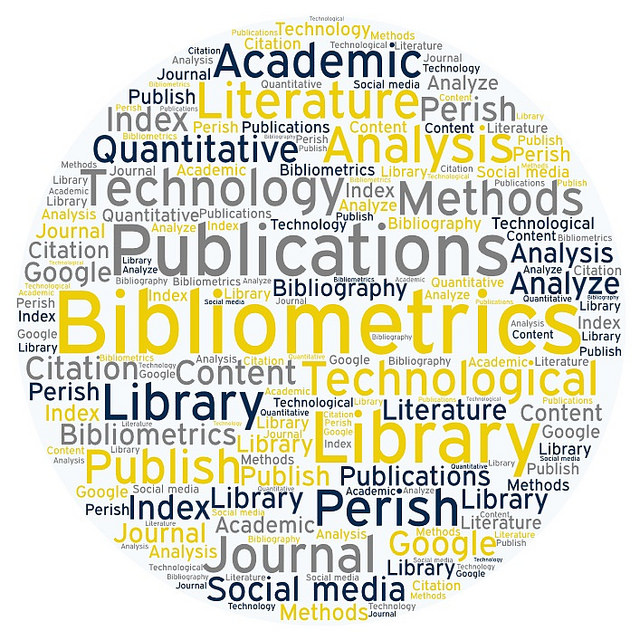A Q/A with Abby Adamczyk: Using Bibliometrics to Evaluate Scholarly Research
April 5, 2017
Abby Adamczyk is the Liaison Librarian for Medicine at Drexel University. As a liaison librarian, she teaches the scholarly literature and information research skills needed by students in medicine and the biomedical sciences. Abby also partners with faculty and students to develop greater awareness of research data management practices and trends in scholarly communications.
 Abby recently attended a bibliometrics and research assessment symposium hosted by the National Institutes of Health Library and the Special Libraries Association (SLA) Maryland Chapter. Following the symposium, I sat down with Abby to learn more about bibliometrics and how they can be used by researchers, administrators and students at Drexel University.
Abby recently attended a bibliometrics and research assessment symposium hosted by the National Institutes of Health Library and the Special Libraries Association (SLA) Maryland Chapter. Following the symposium, I sat down with Abby to learn more about bibliometrics and how they can be used by researchers, administrators and students at Drexel University.
Q: First, tell me about bibliometrics.
A: Bibliometrics is a way to measure and analyze the scientific impact of written publications. In academia, one of the most common metrics used to evaluate journal articles and other academic publications is citation count--the number of times an article or other publication is cited by someone else. It might seem easy enough, but using citation counts in particular can be complicated. Citation counts can be influenced by a lot of different factors like for example, the visibility of an article, the relevance of the topic, and the reputation of the authors. That's why bibliometrics is its own field of study--researchers are trying to improve on the metrics we use to evaluate the value of publications and research.
Q: Why would anyone want to look at bibliometrics?
A: Metrics can be really useful measurements for researchers and students. Researchers might look at certain metrics to help them decide where to publish. For example, if a researcher wants to publish her work in the most prestigious journal in her field, she might look at different metrics to help her determine which journal is the best. You can also look at author metrics if you're trying to identify potential research collaborators or to help build your professional network. Administrators also use metrics to identify trends or important people or topics in a given field as well.
One of the ways in which bibliometrics can be useful is for students who are just getting into a research discipline. They may be unfamiliar with the important journals in their field. Impact factors can help them decide which journals they should be reading and which are considered the leading journals in their field.
Q: What are some of the different metrics commonly used by researchers today?
A: There are a bunch of different metrics that look at different elements of scholarly communications. So for example, there are specific journal metrics that help researchers assess the impact of a single journal or measure journals in comparison to others. Journal metrics include the Journal Impact Factor, Scimago Journal Rank, and Scopus Compare Journal feature.
There are also author-level metrics, and the most commonly used metric to measure an individual author's impact on her field is the h-index. The h-index attempts to measure an author's impact based on the citation rates of their publications.
Q: Recently, we've seen the rise of altmetrics. How is a metric like this being used by researchers? Is it becoming as important as metrics like the Impact Factor?
A: Altmetrics are a new metric used by researchers. Altmetrics are non-traditional metrics that measure the impact of published research through 'buzz' on the social web. They might look at the number of times an article was shared or mentioned on Facebook or Twitter or discussed in a blog. They can also pull from repository records and news mentions. These can supplement more traditional metrics and help create a more complete picture of scholarly activity. Altmetrics data are also gathered faster and give you nearly real-time indication of impact.
Q: There is increasingly strong criticism of metrics like the Impact Factor. What's your opinion of this? Do you see the use of metrics changing in the future?
A: There are some biases inherent in the impact factor as a metric. They're very dependent on the publication rate of a research discipline, so the impact factors of journals cannot be compared across disciplines. But the real problem appears when someone tries to evaluate an individual article by the impact factor of the journal it was published in. The articles published in a journal can vary greatly and impact factor measures the journal as a whole, not the individual articles that make up the journal.
Having said that, I don't see the impact factor disappearing as a metric, and I think it will continue to be a useful way to evaluate journals. The change will be in how we measure the impact of individual articles. Researchers in the field of bibliometrics are developing new ways to measure impact of individual articles--often still based on citation count--that attempt to account for differences in discipline and other factors.
If you're interested in learning more, I recommend reading the Leiden Manifesto, published in the journal Nature in 2015, which talks about ways to improve bibliometrics. I also recommend the 2016 PLOS Biology paper on the Relative Citation Ratio, a new metric developed at the NIH [National Institute of Health].
Q: What is Drexel Libraries doing to support faculty and students around the use of metrics?
A: Drexel Libraries licenses access to Journal Citation Reports, which releases current impact factor measures for journals. We also consult with faculty who have questions about bibliometrics, such as when to use the different types of metrics and how to best use them to evaluate journals, articles and authors. Librarians also help administrators seeking to identify institutional trends in research to look at bibliometrics.